Muslim/Islamic Wedding Rituals
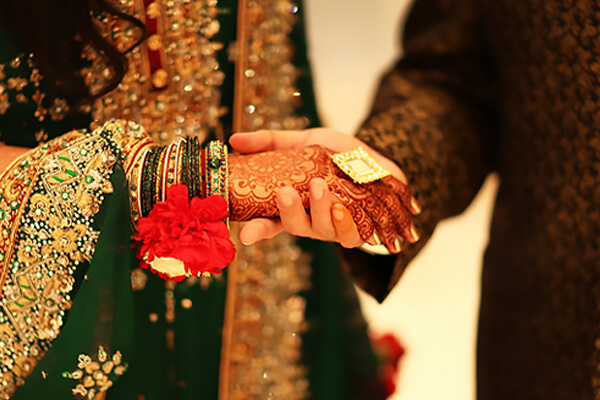
World’s second-largest religion – Islam, adheres to many wedding customs which are no less than the heritage and honor of Islam. A Muslim wedding rituals comprises scores of wedding rituals that are intricately planned with a thoughtful perception.
Marriage is the core responsibility of every Muslim follower that unites two souls and their families and then paves the way for religious preservation as their family grows. Commonly known as “Nikaah” a Muslim wedding is a three-day-long celebration of love and compassion for the bride and groom as well as for their close ones as per the Muslim / Islamic Wedding Dates 2024.
Though Muslims belong to distinct and far places in the entire world, some common Islamic wedding rituals fuse their reverence towards their culture and religion. Most of these weddings happen at Uttar Pradesh destination weddings and weddings in West Bengal and Bihar. A glance at significant Muslim wedding rituals that are categorized mainly into three parts – Pre-wedding rituals, Rituals on the Wedding day and Post-wedding rituals.
Pre-wedding rituals in the Islamic or Muslim culture
Salatul Ishtikara –
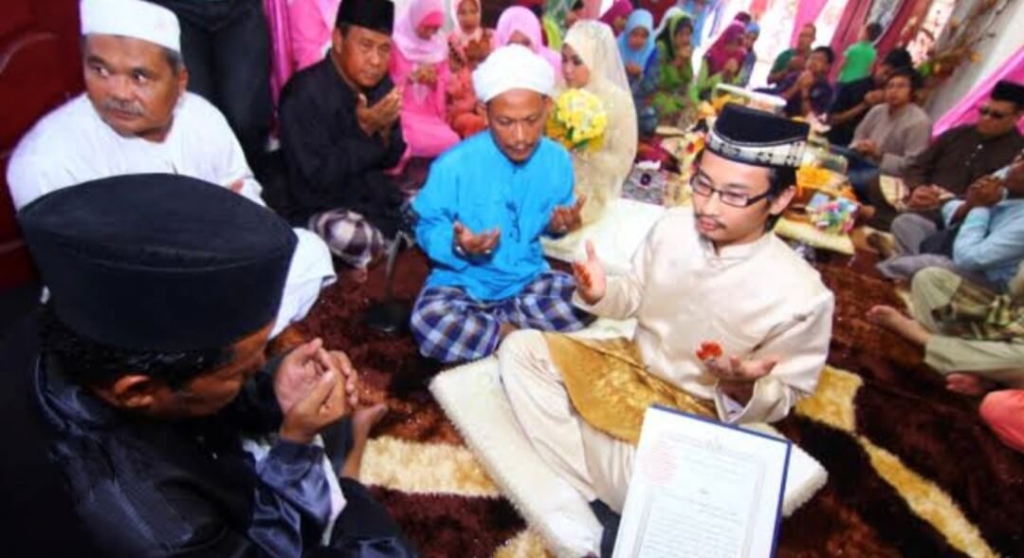
Image source: SoundVision.Com
Arranged marriages are quite prevalent in the Islamic culture where parents of a boy and girl fix the marriage after deeming both of them compatible with each other. Once the marriage is final, the would-be bride and groom visit the nearby mosque with their close ones. Here the religious head of the mosque, commonly known as Imaam, initiates the prayers. Under his guidance, the couple seeks the guidance and blessings of Allah through a short prayer. This prayer is recognized as Salatul Ishtikara. It is a very intimate gathering of the groom’s and bride’s families where the close ones ask for the consent of Allah for uniting two souls in a relationship. This initial pre-wedding ritual is also an official announcement of the wedding by the parents of the bride and groom.
Check this also Kashmiri Rituals Muslim Wedding
Imam Zamin –
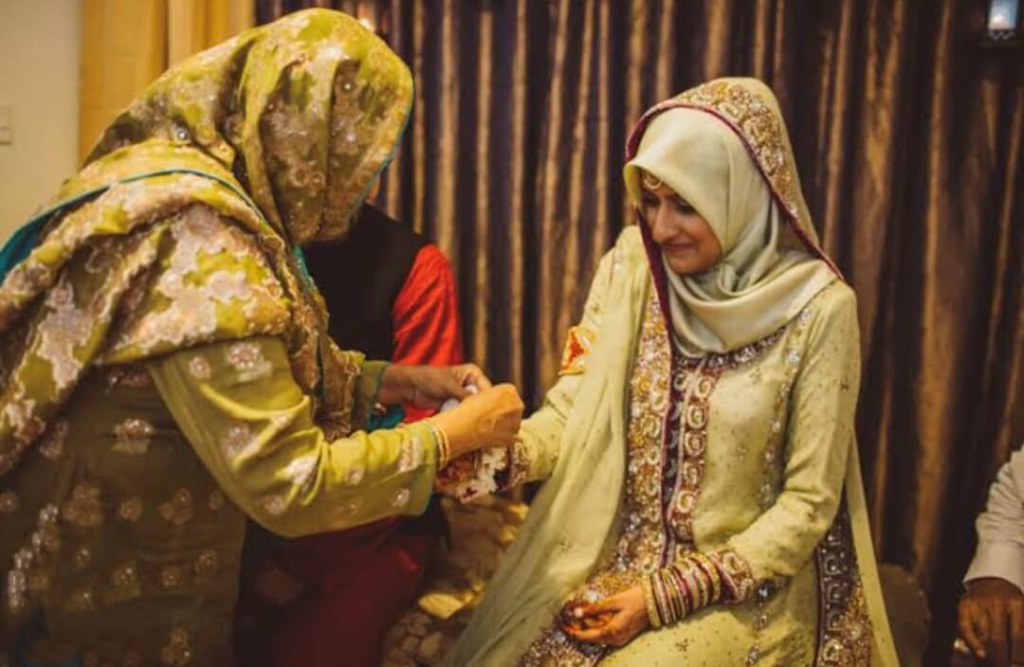
Image source: ShaadiWish
Right after a few days of formal announcement or Salatul Ishtikara, the mother of the groom visits the homes of her soon-to-be daughter-in-law on a very auspicious day. She brings several gifts, sweets, jewelry and clothes for the bride and a silver or gold coin. This silver or gold coin is wrapped in a silk cloth which is tied on the wrist of the bride by her would-be mother-in-law. This pre-wedding ritual in the Muslim community signifies the acceptance of the bride by her in-laws and she will be welcomed warmly in her would-be husband’s home. While leaving the bride’s home, the groom’s mother blesses her and assures the family of a respectful welcome of the bride in the future.
Check this also Kashmiri Rituals Hindu Pandit Weddings
Mangani –
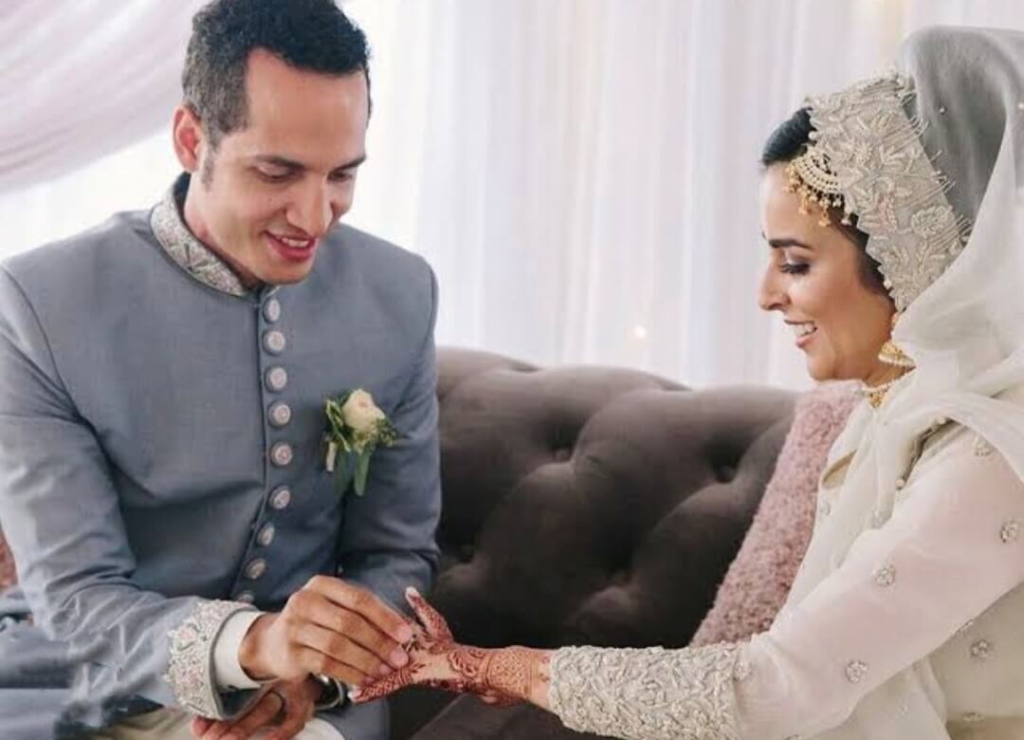
Image source: The Knot
The ceremonial gathering of all the family members, close relatives and friends belonging to both sides for witnessing the “Exchange of Rings” between the lady of the hour and handsome groom is the Mangani ritual of the Islamic wedding culture. During the ring exchangement, the well-wishers shower blessings through gifts, clothes, sweets, dry fruits and cash etc on the couple. First, the groom’s family presents the gifts for the bride and then the bride’s side follows the ritual. Usually, the rings for Mangani are picked by the parents but these days couple purchases them for each other by shopping together. After Mangani both of them become each other’s betrothed.
Check this also Wedding rituals in Bihar
Manjha –
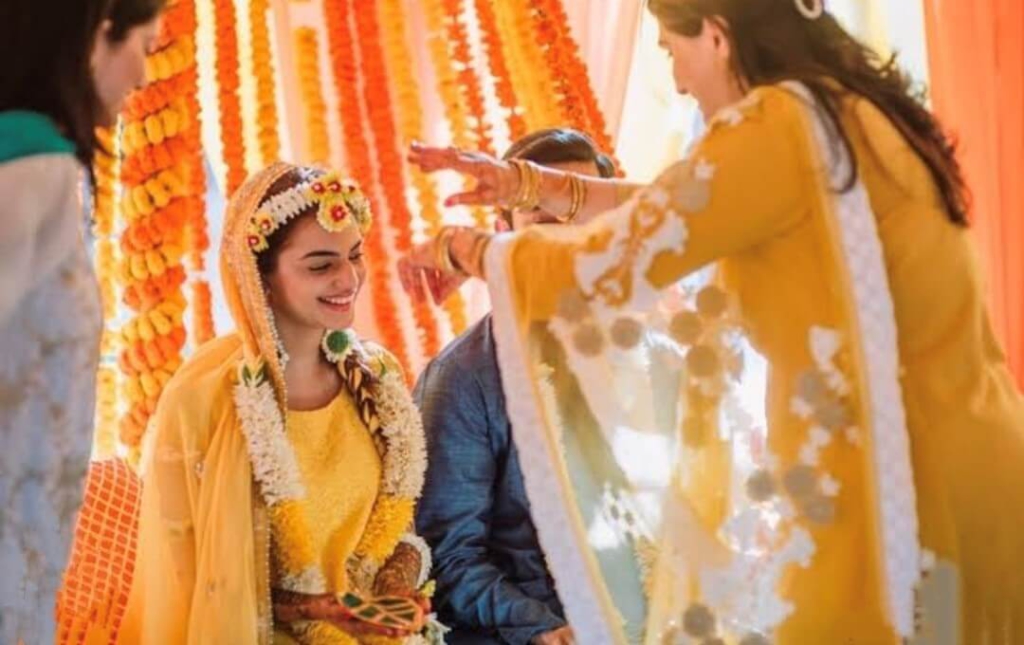
Image source: Navdeep Soni Photography
This ritual is prevalent among the Muslims who reside in India. Popularly known as the Haldi ceremony in other religions or sects, Manjha takes place two or three days before the Nikaah or D-day in Muslim wedding culture. Traditionally, the groom’s side sends the paste of turmeric, rose water and sandalwood powder to the bride’s home. At the bride’s home, the women apply this paste on the face, hands and feet of her body. After the completion of the customary application of this paste, this ritual turns into a fun activity as the entire family lovingly rubs it on each other’s faces. A similar ritual occurs at the groom’s place. After the Manjha ceremony, the bride and groom are not allowed to go outside of their homes. Turmeric also poses several qualities of enriching the beauty and glow of skin, hence Manjha ceremony is also conveyed as a pre-wedding skin care of the bride and groom. Apart from it, the auspicious yellow colour of the turmeric symbolizes the purification, healing and fertility boosting of the couple.
Check this also Bengali Wedding Rituals
Heena or mehendi ceremony –
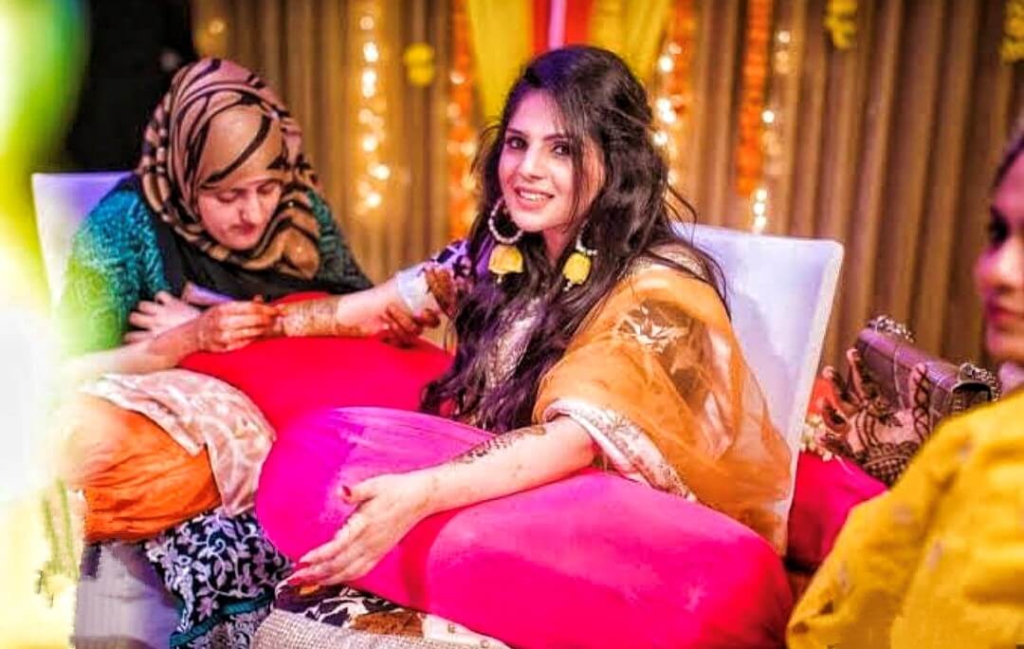
Image source: WeddingWire
A women and bride-centric ritual is celebrated on the wedding eve at the bride’s home or the wedding location. In ancient times, all the women and girls on the bride’s side were used to surround the bride and one of the women draw intricate designs with Heena paste on the bride’s hands and feet. These days professional heena artists are hired for this task. The designs of the Bride’s palms include the initials of her would-be husband and he is challenged to find it on the first night after the wedding. Other female members also paint their palms with henna paste. It is also believed that the darker the colour of the bride’s heena, the denser love she will receive from her husband. During and after the Heena ceremony the family members dance and sing with great enthusiasm.
Check this also Buddhist Wedding Rituals
Sanchaq –
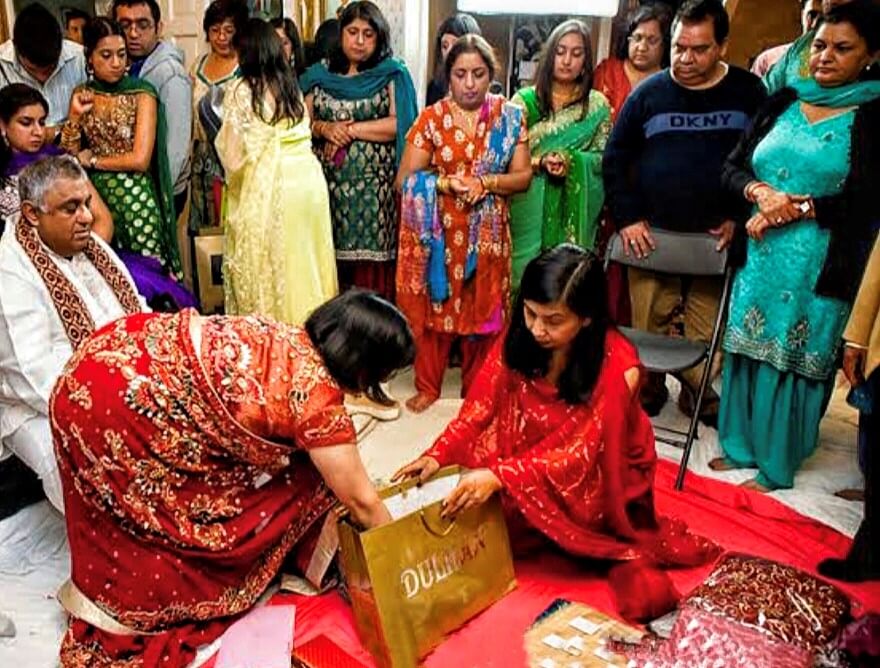
Image source: Real Life Photography
With this thoughtful ritual, the pre-wedding festivities in a Muslim wedding come to an end. A day before the big day, the groom’s family visits the bride’s place but without the groom. They bring gifts, sweets and the wedding outfit of the bride with precious and matching jewelry. It is expected that the bride will adorn herself with this attire and accessories for the Nikaah ceremony. The thought behind this warm visit of the groom’s family in the bride’s home is, they are depicting their love, support and care for the bride. All those valuable gifts are collectively called Sanchaq.
Check this also Nepali Wedding Rituals
The exciting yet meaningful D-day rituals in the Muslim Wedding Rituals
The enormous celebration of love begins on the wedding day when both the families and bride & groom have a glimpse of each other. All major emotions like fun, sensitivity and happiness come across the minds of people who are there to witness the pious union of two individuals.
Baraat –
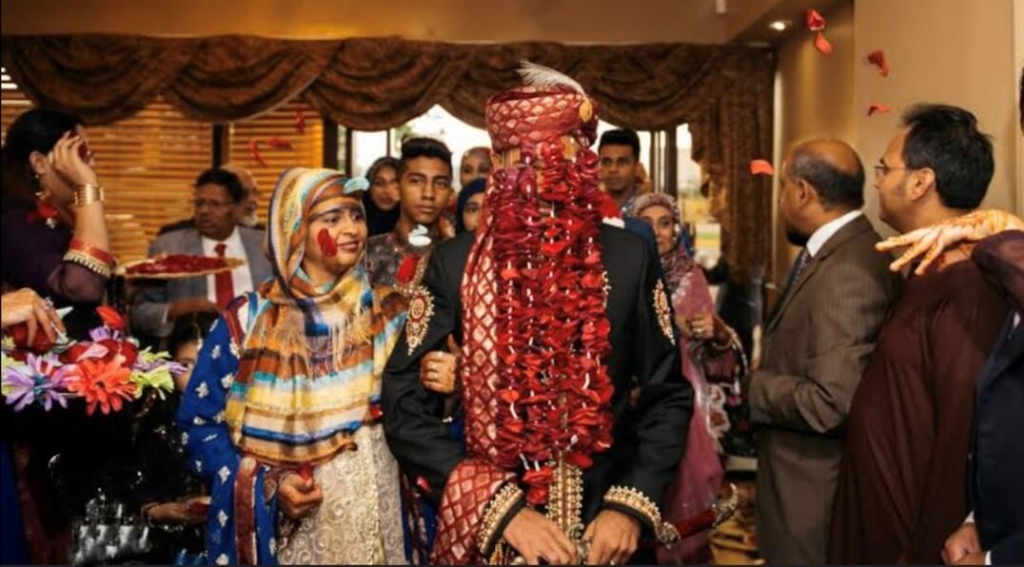
Image source: GetEthinic. com
The wedding celebrations begin with the procession of the groom who is accompanied by his close friends, cousins and relatives. The well-dressed groom embarks on a short tour in a finely decorated car sent by the bride’s family. Usually, the brother of the bride goes to lead the path of Baraat. The other family members of the groom follow this groom’s procession and reach the pre-decided wedding venue with great pomp and splendor.
Check this also Pagan Wedding Rituals
Welcome –
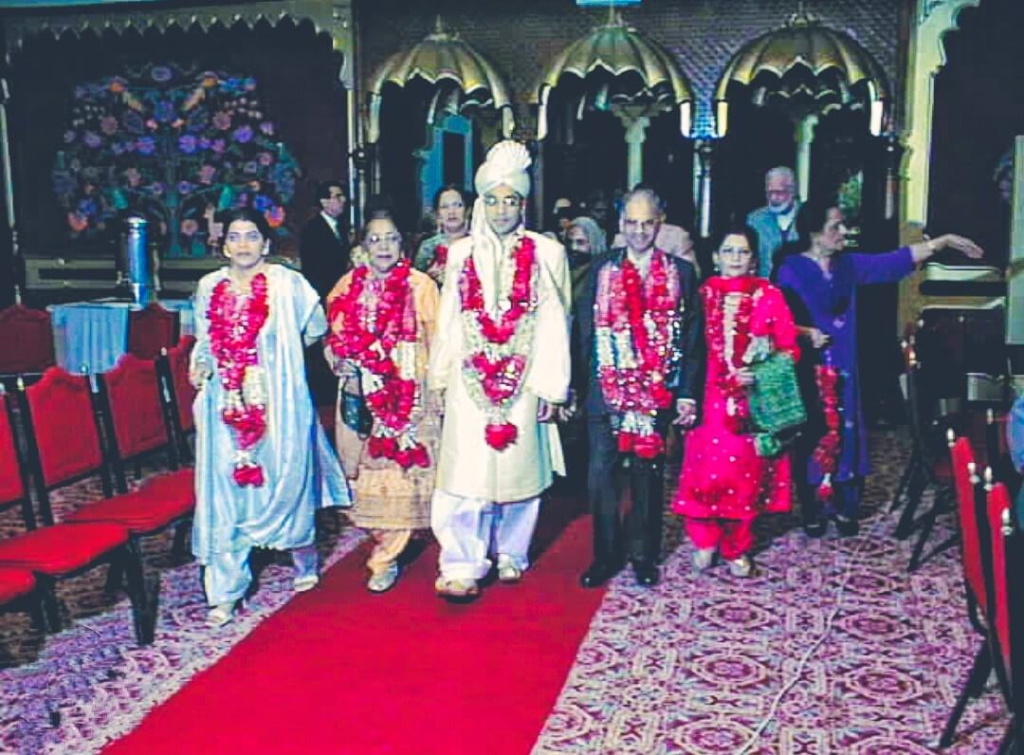
Image source: Desievite
After reaching the wedding venue the groom and his entire circle are warmly welcomed by the elders of the bride’s family. Especially the brother figures of the bride greet the groom wholeheartedly and share a sweet drink (Sharbat). This signifies the sweet beginning of the impending wedding or Nikaah and the relationship. The path of the groom is filled and decorated with flower petals and the bride’s side sprinkles the rose water or Ittar on him. The guests also enjoy the music, dancing and refreshing drinks during the Baraat ritual. The groom and important guests also receive some gifts from the family of the bride. This ritual signifies the love and reverence of the bride’s family towards the groom and his entire family and relatives.
Check this also Chinese Wedding Rituals
Nikaah ceremony –
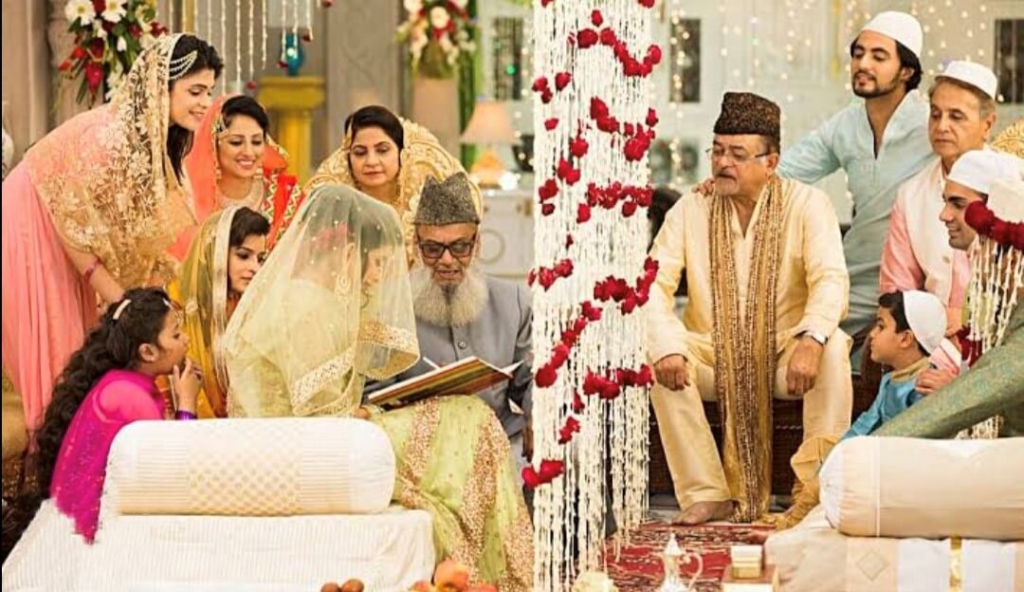
Image source: Yeh Hai India
The Nikaah ceremony is considered quite auspicious for the bride and groom along with their families. A Maulvi or a religious priest is invited by the family members to conduct the Nikaah ceremony according to the directions of the Quran. The females surround the bride and the males sit around the groom during the Nikaah. The father (Wali) of the bride acts as a guardian for the bride and conveys her interest in marriage to all the relatives. The groom’s family offers the pre-decided cash amount to the bride and it is called Meher. This cash is offered to the bride for seeking her consent regarding the marriage. Meher is offered to the bride in two parts – First part is given before the Nikaah while another part is offered after the solemnization.
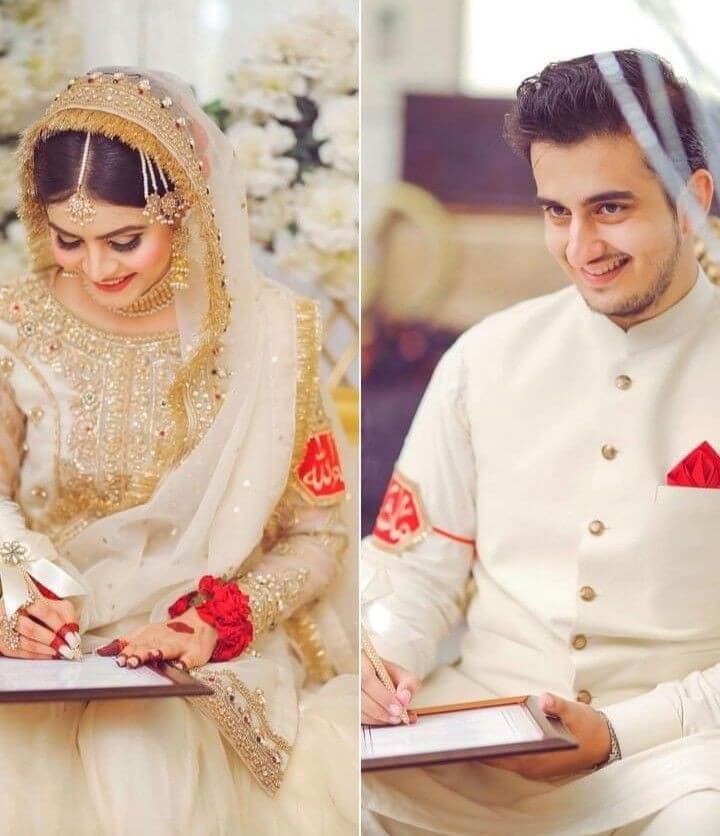
Image source: Pinterest
After accepting the Meher by the bride, the Maulavi initiates the Nikaah by reciting a sacred prayer from the Quran. The Maulvi asks the bride “Qubool Hai?” thrice and she responds “Qubool Hai” in an assertive tone. Now a similar procedure is performed with the groom. It is called the Ijab-e-qubool ritual. After this bride and groom sign the Nikaahnama which is a legal paper of uniting both individuals in a sacred relationship. The Nikaahnama depicts the duties of each partner according to the preachings of the holy Quran. The maulvi recites Khutuba in front of the bride and groom which are equivalent to the wedding vows of other cultures. The bride and groom carefully listen to these vows and show the acceptance of all marriage vows. At least two witnesses sit on both sides for assuring others about the credibility of Nikaah. In the end, all the elder ones shower blessings on the bride and groom for their new endeavor. During the entire Nikaah ceremony, the bride and groom sit separately and do not see each other.
Check this also Mormon Wedding Rituals
Fatihaa –
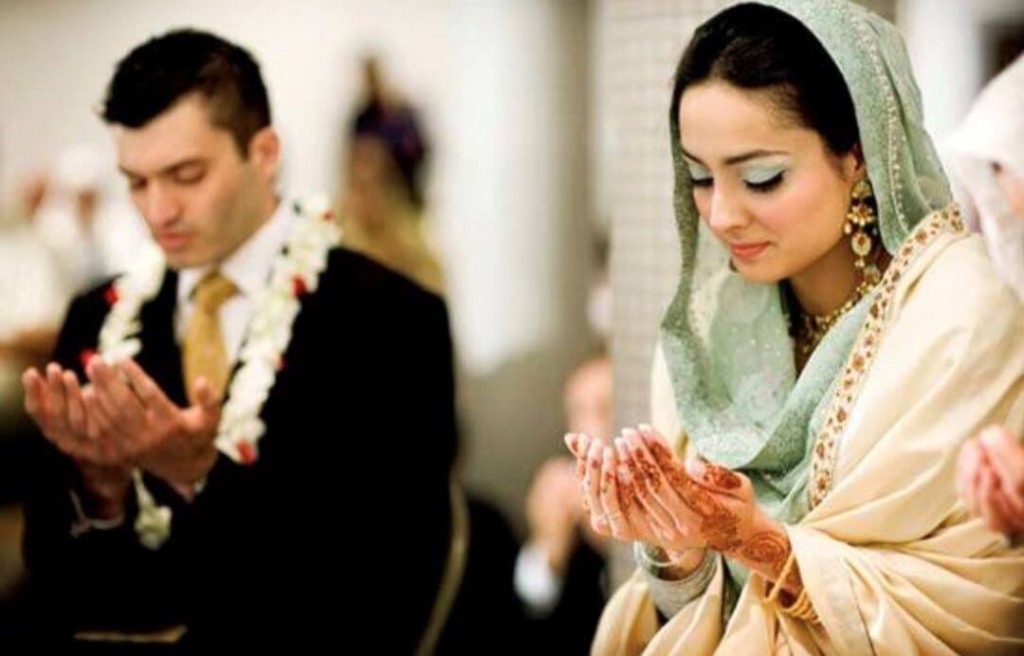
Image source: Pinterest
Fatihaa is the first verse of the Quran and the recital of Fatihaa follows the Nikaah ceremony. In the presence of the couple and their close family members, the leading priest or Maulavi reads Fatiha. This ritual conveys the blessings and guidance of Allah to the newly wedded couple. In the end, family members eat Knafeh and Baklava with coffee altogether. Fatihaa Padhna is quite an intimate custom in which only family members take part.
Check this also Korean Wedding Rituals
Arsi Mushraf –
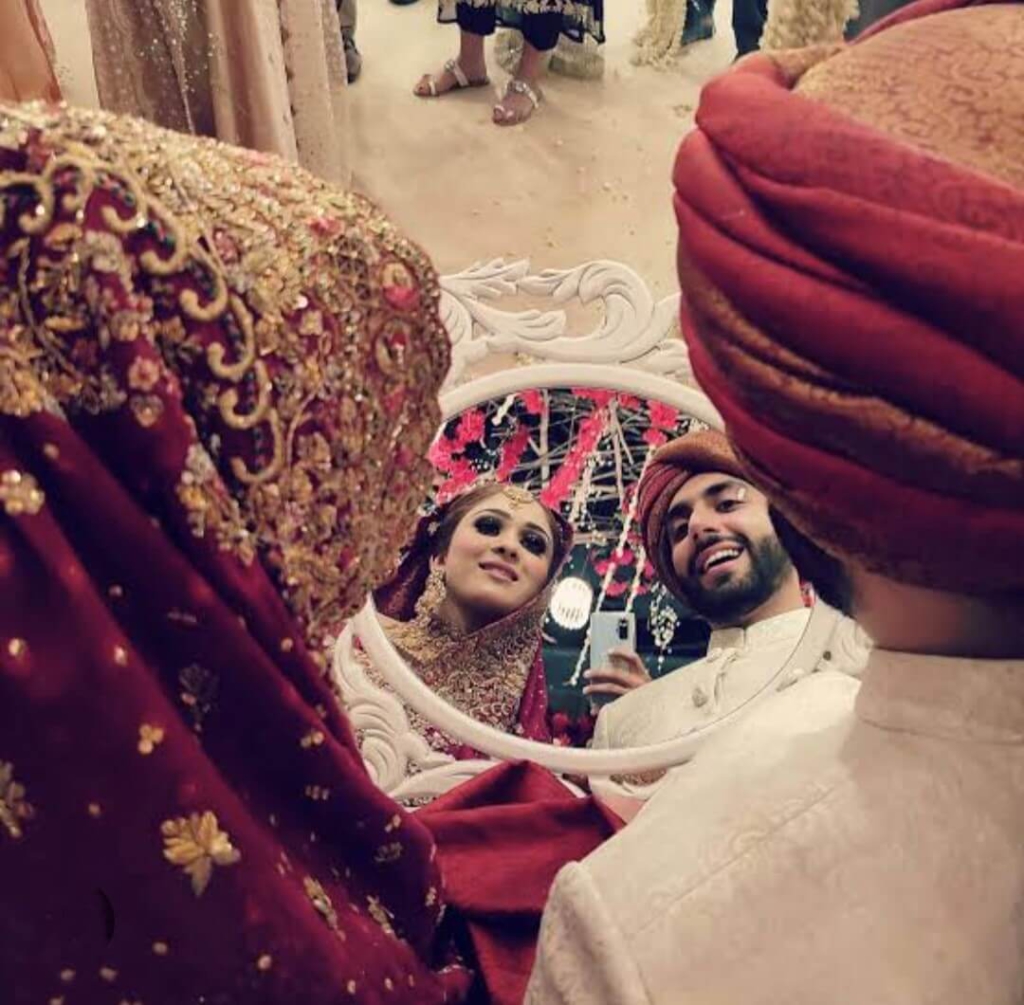
Image source: Pinterest
Now the bride and groom can lay eyes on each other after the completion of the Nikaah ceremony. A very unique way is designed to take a glimpse of each other in Islamic wedding culture. The bride and groom sit next to each other and the holy Quran is placed between them. Their heads are still covered with a veil and sehera. A mirror is also placed between them in which the bride and groom see the first reflection of their spouse. This ritual concludes the wedding ceremonies in the Muslim community.
Check this also Jewish Wedding Rituals
Post-wedding rituals in the Islamic religion
Rukhasat –
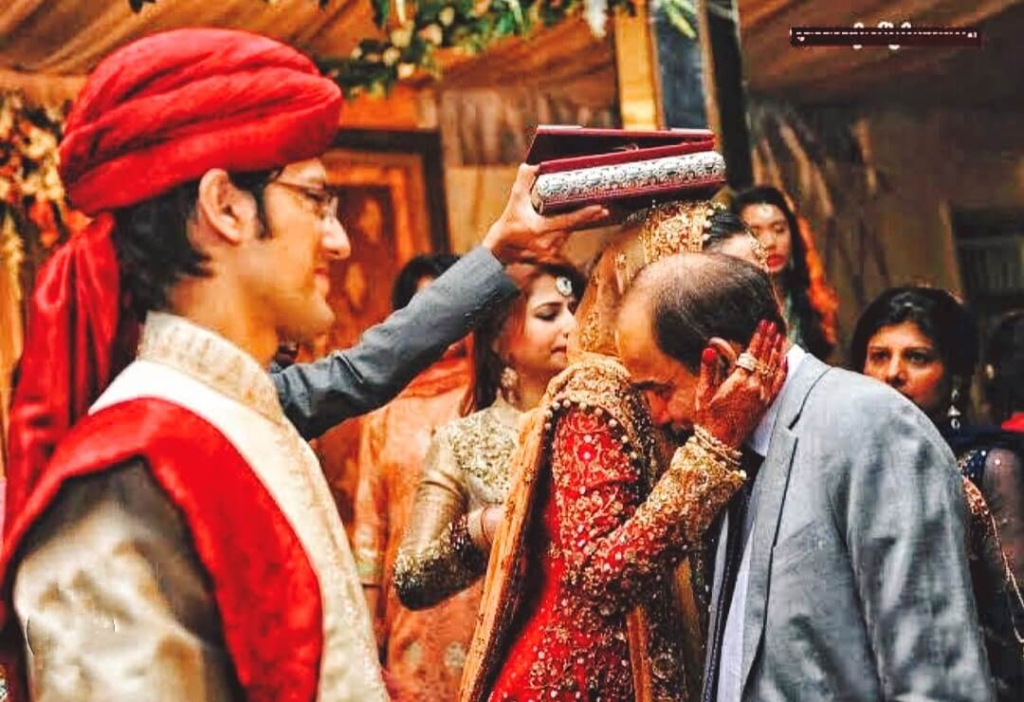
Image source: WeddingSutra
An emotional goodbye initiates the post-wedding customary duties of the couple and their families. Now the bride leaves her paternal home and bid a teary goodbye to her loved ones. She heads towards her husband’s home where her mother-in-law welcomes her warmly and touches the sacred Quran on the head of the bride. This ritual reminds the duties of a woman in her wedded life. All the family members of the groom also embrace the arrival of the bride with love and warmth.
Check this also Iyengar Wedding Rituals
Waalimah –
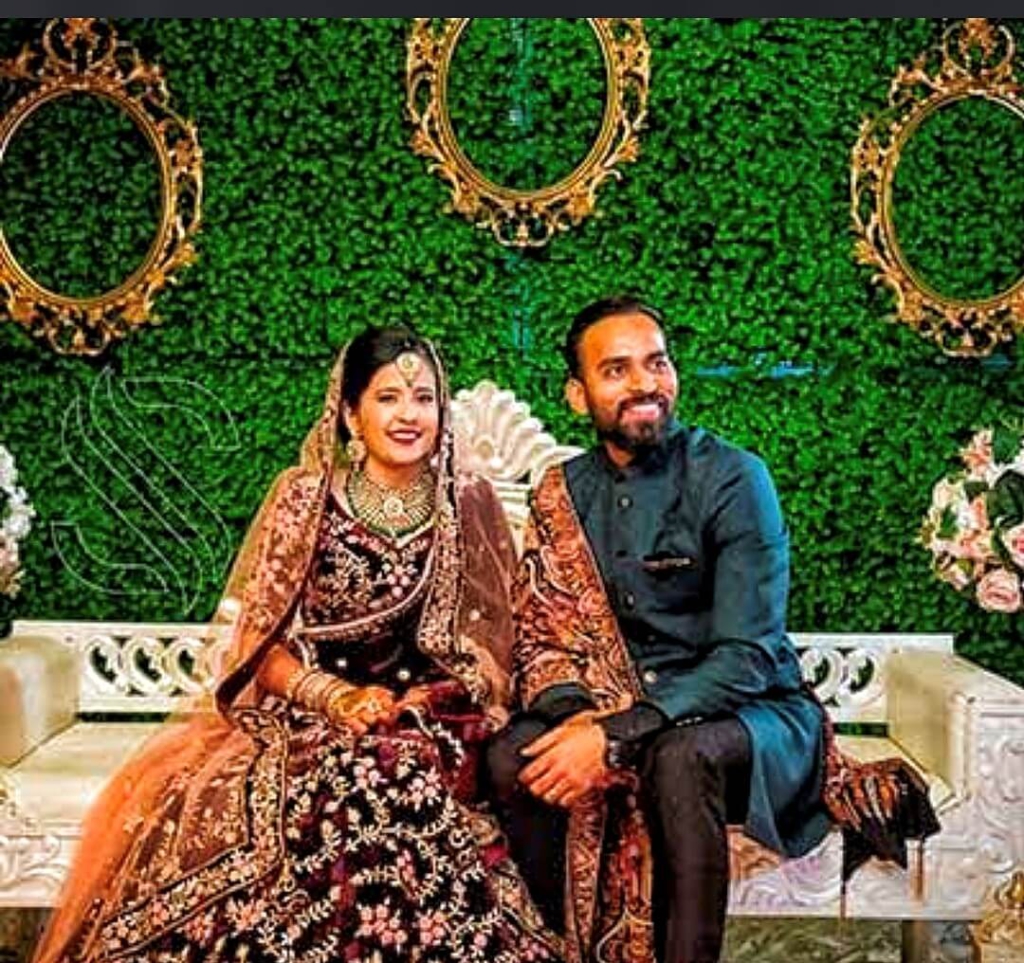
Image source: Symphony Events
Also known as Dawat-e-Dalimah, this is the very second ritual of the post-wedding celebration at the groom’s place. A grand and lavish party is arranged by the groom’s side where close and distant relatives, friends and neighbors are invited to bless the newly married couple. This blessing ceremony is followed by a traditional feast in which everyone enjoys sweet drinks and a variety of food items. Muslims usually do not allow the inclusion of alcohol in sacred wedding rituals. This greeting ceremony is spiced up with peppy music, dance, enjoyment and a lot of fun by the family members of the groom so that bride can fit herself in the friendly environment. The guests bless the royal couple with several gifts, jewelry and cash to show their love towards them.
Check this also Kerala Wedding Rituals
Chauthi –
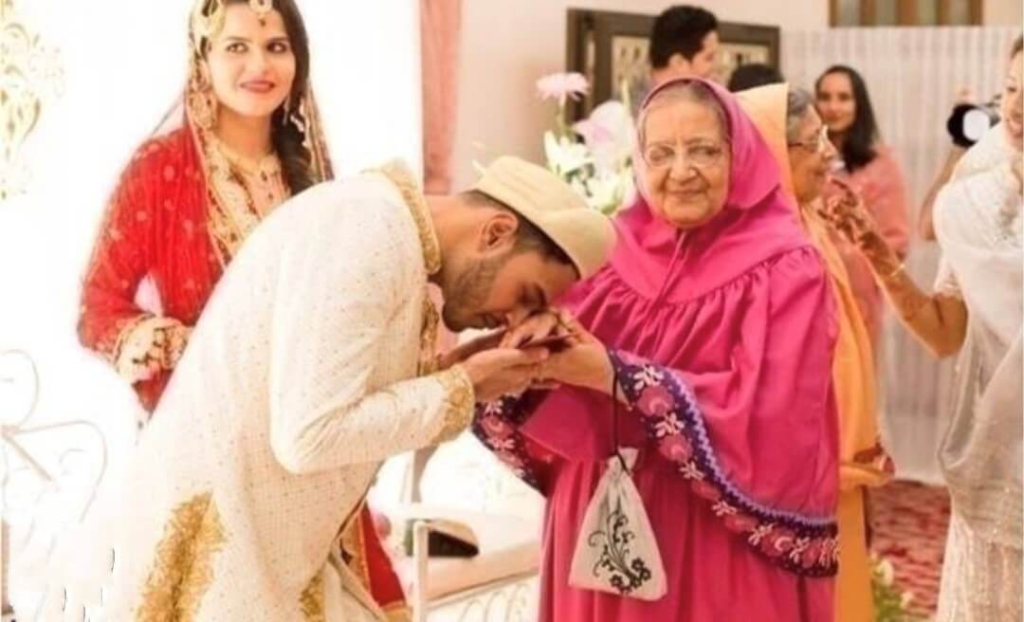
Image source: Weddingz. in
Akin to the other Indian cultures’ wedding ritual, the bride visits her paternal home four days after her wedding. The bride comes home with her husband where everyone bids the couple welcome with dense love. After greeting them, a sumptuous meal is offered by the bride’s family to the couple. This meal marks the end of the three-day-long wedding celebration and the couple returns to their new home with gifts, blessings and prayers of all loved ones.
Check this also Kannada Wedding Rituals



